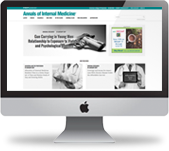Working toward fundamental change
ACP engages in a significant number of efforts on its own and with external organizations to help move the health care system to one that better addresses its vision for better health care.
“The American health care delivery system is in need of fundamental change.” This is the opening sentence of the 2001 Institute of Medicine (IOM) report titled “Crossing the Quality Chasm: A New Health System for the 21st Century,” one of the first health policy documents that I worked on in my career. I served as a research assistant who conducted numerous literature searches as we drafted the report and then checked every single reference in that document prior to publication. And yet, over 20 years later, as I move into my new role as ACP's Chief Advocacy Officer, we are still seeking fundamental change in our health care delivery system.
The parallels between “Crossing the Quality Chasm” and “Better Is Possible: ACP's Vision for the U.S. Health Care System,” published in 2020, are remarkable. The 2001 IOM/National Academies of Sciences, Engineering, and Medicine (NASEM) report outlined six aims for improvement—that health care should be safe, effective, patient-centered, timely, efficient, and equitable—which are also weaved throughout ACP's New Vision. In fact, one of the fundamental components of ACP's policy is that we envision “a health care system where payment and delivery systems put the interests of patients first, by supporting physicians and their care teams in delivering high-value and patient-centered care.” ACP also calls for “a health system that ameliorates social factors that contribute to poor and inequitable health (social determinants); overcomes barriers to care for vulnerable and underserved populations; and ensures that no person is discriminated against based on characteristics of personal identity.”
Some progress has been made, of course. Over the last two decades, there has been significant implementation of value-based care delivery models, from the patient-centered medical home (PCMH) to accountable care organizations (ACOs) and many others that have demonstrated some success in moving the U.S. in the direction of improving patient care and population health while reducing cost. Since the establishment of the CMS Innovation Center, the agency has initiated nearly 100 new payment and service delivery models that involve Medicare and Medicaid, as well as private payers. Yet, we still have a long way to go, with a Jan. 28 report in JAMA Health Forum finding that most physician compensation continues to be based on volume of services instead of value of care.
In ACP's New Vision, the College reflects on how value and quality of care should be defined and ultimately calls for value to be “defined around the patient, including the processes of care they receive, their clinical outcomes, their own health and health care goals, their safety, and their experience and engagement with their care.” The complexities as to how to measure quality as a component of value are also discussed, particularly given the variable entities involved in measurement and the intent of measurement—whether for quality improvement purposes or external accountability. Ultimately, the College recommends that value-based payment programs move “toward a limited set of patient-centered, actionable, appropriately attributed, and evidence-based measures for public reporting and payment purposes, while also supporting the use of additional clinically meaningful measures for internal quality improvement.”
With this in mind, ACP engages in a significant number of efforts on our own and with external organizations to help move the health care system to one that better addresses the IOM/NASEM aims and our own New Vision. We provide regular feedback to the CMS Innovation Center on how it can improve the implementation of new models, provide greater opportunities for primary care practices to engage in new and existing models, advance health equity though alternative payment models, and ensure that the measures used in its models and the broader Quality Payment Program (QPP) are valid and meaningful. Most recently, the College commented on how the Innovation Center could better address the objectives laid out in its new strategy refresh, a document that outlines its plans to use broader measures of model success, such as equity, care delivery, transformation, patient outcomes, and market characteristics.
ACP's Performance Measurement Committee has reviewed hundreds of measures used in the QPP—both within the Merit-Based Incentive Payment System (MIPS) and the Alternative Payment Models (APM) pathway—and has found a good proportion of them to be invalid as currently designed and provided CMS with technical recommendations as to how to improve them.
We also actively engage in related efforts, including having staff and members serve on committees of the National Quality Forum (NQF), which conducts a measure endorsement process for those used in public reporting and pay-for-performance programs; participating in the Measure Applications Partnership, a public-private partnership convened by NQF to provide input to HHS on the selection of performance measures for use in their programs; and serving on the Core Quality Measures Collaborative (CQMC) steering committee, which is intended to help align performance measures used across various models and payers. This work with multiple stakeholders is important but has limitations, since it can be difficult to make any meaningful change with so many perspectives at play.
To try to make more progress on the ground, the College developed a Medical Neighborhood Model (MNM), a multipayer payment model intended to improve coordination between specialty practices and primary care practices that refer patients to them, offering opportunities for these practices to provide advanced support to their patients. This model was thoroughly reviewed by HHS's Physician-Focused Payment Model Technical Advisory Committee (PTAC), which ultimately recommended that CMS test the model to refine it for potential broader implementation. However, like all other PTAC-recommended models, our model has not yet been tested as proposed. Instead, the CMS Innovation Center has utilized components of PTAC-recommended models in its own initiatives.
ACP also submitted two MIPS Value Pathway (MVP) proposals to CMS focused on chronic care management and preventive care. Our submissions included only measures that ACP's Performance Measurement Committee approved and made recommendations for improvements to additional measures for potential inclusion. At this time, CMS has finalized a Chronic Care Management MVP to be initiated in 2023, which is promising; however, the agency did modify it from our initial proposal. We are expecting a version of our preventive care MVP to be included in future rulemaking.
The past 20-plus years I have spent trying to improve our delivery and payment system to reflect the aims outlined in the “Crossing the Quality Chasm” report have been filled with a lot of ups and downs, and the work that ACP has done to initiate and facilitate change has made a difference. Moving forward, I am optimistic that further progress will be made if we are steadfast and bold in our recommendations and actions. The COVID-19 pandemic has demonstrated that system change can happen more rapidly when needed. Now is the time to take advantage of all that we have learned and finally implement the fundamental change called for in 2001.





